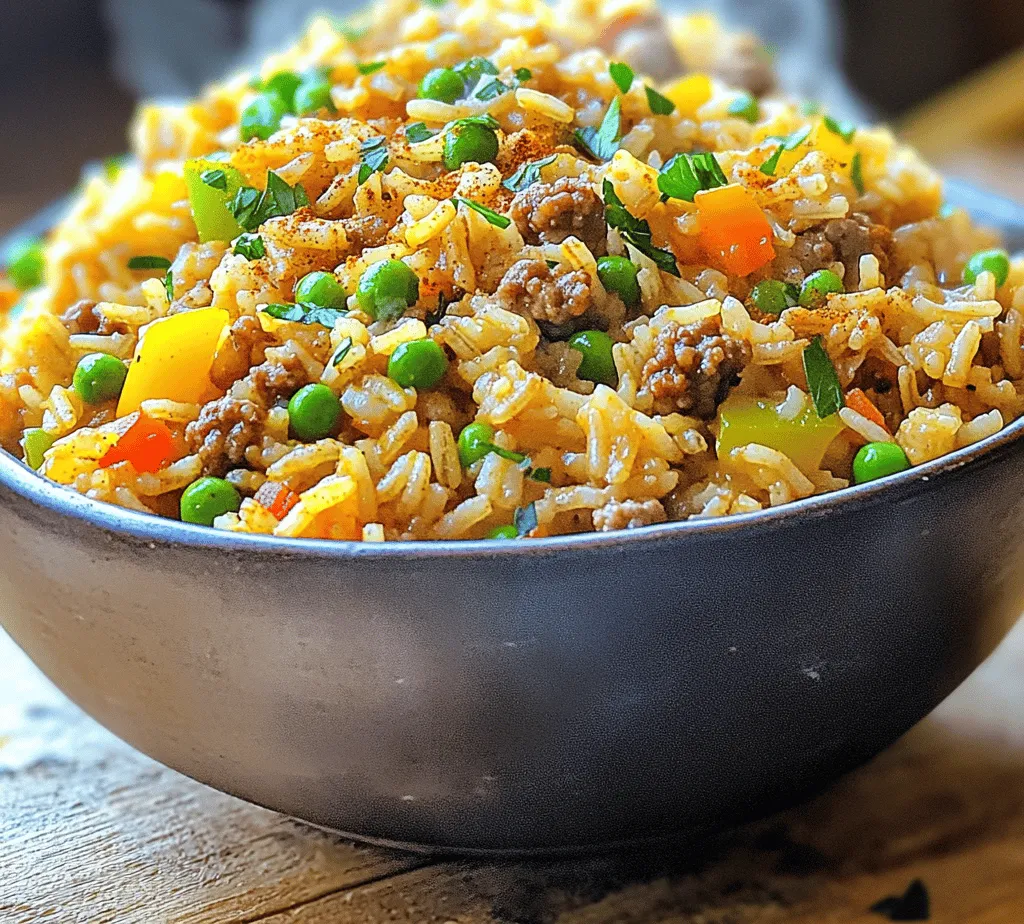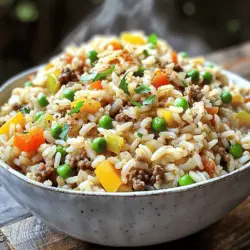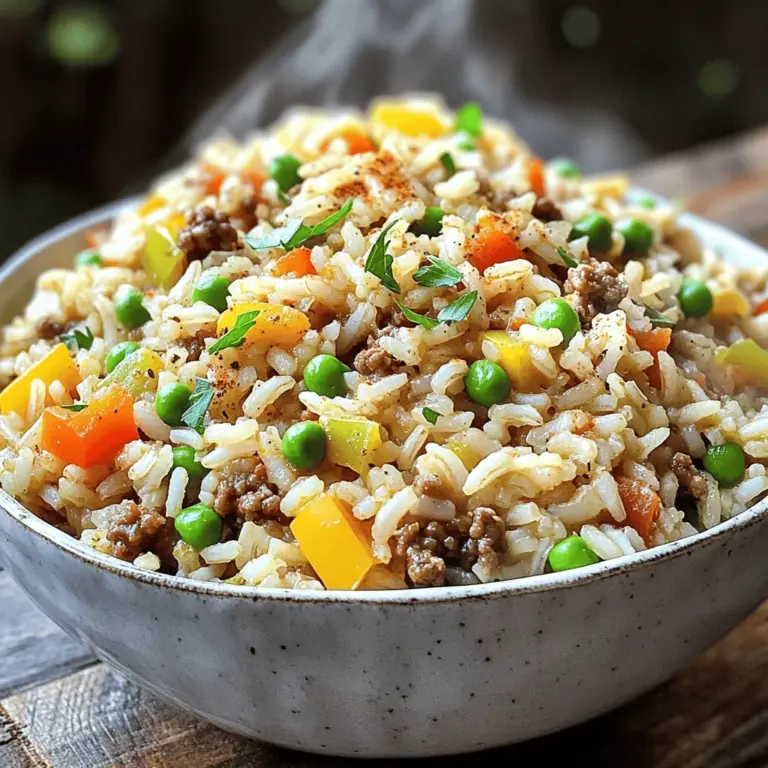Introduction
Southern cuisine is a vibrant tapestry of flavors, textures, and culinary traditions that have evolved over centuries. Rooted in a rich cultural heritage, Southern cooking is celebrated for its hearty dishes, seasonal ingredients, and bold spices. One such dish that exemplifies the essence of Southern cooking is Dirt Rice, a savory and satisfying staple that brings together the comforting qualities of rice with a medley of flavors that are both familiar and exciting.
Dirt Rice, also known as Dirty Rice, is a beloved dish in Southern households, often gracing dinner tables during family gatherings and festive occasions. This dish is not only a testament to the creativity of Southern cooks, but it also showcases the versatility of rice as a base that can take on a variety of flavors, making it suitable for any family meal. With its rich history and delicious taste, Dirt Rice has become a go-to comfort food that appeals to both the young and the old.
The key to crafting the perfect Dirt Rice lies in the use of fresh ingredients and bold spices. Each component plays a crucial role in building layers of flavor that come together harmoniously to create a dish that is anything but ordinary. Whether you’re looking for a hearty weeknight dinner or a dish to impress guests, Spicy Southern Dirt Rice is sure to satisfy.
Understanding Dirt Rice
To truly appreciate Dirt Rice, it’s essential to delve into its historical background and cultural significance within Southern cuisine. Originating from Louisiana, Dirty Rice has its roots in Creole and Cajun cooking. Traditionally, it was made by combining leftover rice with whatever meats and vegetables were on hand, creating a dish that was both resourceful and delicious. The use of ground meats, such as chicken or pork, along with the classic “holy trinity” of Southern cooking—onion, celery, and bell pepper—gives the dish its distinct flavor profile and hearty texture.
The term “dirty rice” refers to the way the rice takes on a darker hue from the spices and seasonings used in the dish, particularly when mixed with ground meat and vegetables. This “dirtiness” is not a reflection of the dish’s cleanliness; rather, it signifies the depth of flavor achieved through the blending of ingredients. Unlike traditional rice dishes that may focus solely on the grain itself, Dirt Rice is a flavorful amalgamation that highlights the harmony of various components.
In addition to its rich flavor, Dirt Rice also offers nutritional benefits. The ingredients typically used in the recipe provide a balanced meal, with long-grain rice serving as a source of carbohydrates, while the meat and vegetables contribute essential proteins, vitamins, and minerals. Ground turkey or chicken offers a leaner alternative to traditional pork or beef, making this dish a healthier option without sacrificing taste.
Ingredients Overview
The success of Spicy Southern Dirt Rice hinges on a few key ingredients, each chosen for its ability to contribute to the dish’s overall flavor and texture. Let’s take a closer look at each component:
Long-Grain White Rice
Long-grain white rice is the perfect base for Dirt Rice due to its fluffy texture and ability to absorb flavors. When cooked properly, it remains separate and doesn’t become sticky, providing a delightful contrast to the savory meat and vegetables. The cooking properties of long-grain rice ensure that it can soak up the rich chicken broth and spices, making every bite a burst of flavor.
Chicken Broth
Using chicken broth instead of water to cook the rice enhances the dish’s flavor profile significantly. The broth adds moisture and depth, creating a more robust and savory base for the other ingredients. Homemade chicken broth is ideal, but store-bought versions can work just as well. Look for low-sodium options to control the salt level in your dish.
Ground Turkey or Chicken
For those looking to keep the dish lean, ground turkey or chicken serves as an excellent protein source. These meats are lower in fat compared to traditional ground beef or pork while still offering a satisfying texture and flavor. They readily absorb the spices used in the dish, ensuring that every bite is packed with flavor.
Vegetables: Onion, Celery, and Bell Pepper
The “holy trinity” of Southern cooking consists of onion, celery, and bell pepper, and they are essential to the flavor foundation of Dirt Rice. Onions provide sweetness and depth, while celery adds a crisp texture and subtle earthiness. Bell peppers bring color and a mild sweetness, creating a well-rounded flavor profile that complements the spices and meat.
Cajun Seasoning, Smoked Paprika, and Cayenne Pepper
The spice blend is what truly defines Dirt Rice. A combination of Cajun seasoning, smoked paprika, and cayenne pepper creates a robust flavor that is signature to Southern cooking. Cajun seasoning typically includes a mix of spices like garlic powder, onion powder, and oregano, while smoked paprika adds a subtle smokiness. Cayenne pepper provides the heat, allowing you to adjust the spice level to suit your taste.
Frozen Peas
Frozen peas add a pop of color and a touch of sweetness to the dish. They also provide a nice contrast to the rich, savory flavors of the meat and spices. Adding peas not only enhances the dish visually but also increases its nutritional value, providing fiber and vitamins.
Olive Oil
Olive oil is used to sauté the vegetables and meat, adding a rich flavor and healthy fats to the dish. It helps to create a nice caramelization on the vegetables, enhancing their natural sweetness and creating a deeper flavor base for the Dirt Rice.
Fresh Parsley
Finally, fresh parsley serves as a garnish that adds a burst of freshness to the dish. Its bright, herbal flavor contrasts beautifully with the richness of the Dirt Rice, making it a perfect finishing touch.
Step-by-Step Cooking Instructions
Creating Spicy Southern Dirt Rice is a straightforward process, perfect for both novice cooks and seasoned chefs. Follow these steps to prepare this delicious dish and enjoy the delightful flavors of Southern cuisine.
Preparation of the Rice
1. Rinse the Rice: Start by rinsing 1 cup of long-grain white rice under cold water. This helps remove excess starch, which can make the rice sticky during cooking. Rinse until the water runs clear, indicating that most of the starch has been washed away.
2. Cook with Broth: In a medium saucepan, combine the rinsed rice with 2 cups of chicken broth. Bring it to a boil over medium-high heat. Once boiling, reduce the heat to low, cover the pan, and let it simmer for about 15-20 minutes, or until the rice is tender and has absorbed all the liquid. Once cooked, fluff the rice with a fork and set it aside.
Sautéing the Vegetables and Meat
3. Heat the Olive Oil: In a large skillet, heat 2 tablespoons of olive oil over medium heat. Allow the oil to warm until it shimmers, which indicates that it’s ready for sautéing.
4. Sauté the Holy Trinity: Add 1 diced onion, 1 diced bell pepper, and 2 diced celery stalks to the skillet. Sauté for about 5-7 minutes, or until the vegetables become soft and translucent. This step is crucial as it builds the flavor base for your Dirt Rice.
5. Add the Ground Meat: Next, add 1 pound of ground turkey or chicken to the skillet. Use a wooden spoon to break up the meat as it cooks. Continue to sauté until the meat is browned and cooked through, which should take about 7-10 minutes.
6. Season the Mixture: Once the meat is cooked, sprinkle in your spice blend, which includes 2 tablespoons of Cajun seasoning, 1 tablespoon of smoked paprika, and 1 teaspoon of cayenne pepper (adjust according to your heat preference). Mix well to ensure the meat and vegetables are well-coated in the spices.
7. Combine Rice and Peas: After the meat is seasoned, gently fold in the cooked rice and 1 cup of frozen peas. Stir everything together until the rice is evenly distributed and all ingredients are well combined.
These initial steps set the stage for creating a mouthwatering dish that embodies the spirit of Southern cooking. In the following sections, we will delve deeper into additional instructions and tips for perfecting your Spicy Southern Dirt Rice, ensuring that you achieve the best results every time you make this delicious comfort food. Stay tuned as we explore more cooking techniques, flavor enhancements, and serving suggestions that will elevate your Dirt Rice experience.

Sautéing Vegetables and Their Role in Flavor Development
The first step to achieving a rich and flavorful Spicy Southern Dirt Rice lies in the sautéing of vegetables. Begin by heating a generous amount of oil in a large skillet or Dutch oven over medium heat. Onions, bell peppers, and celery—often referred to as the “holy trinity” of Southern cooking—should be the foundation of your vegetable base. Sauté these vegetables until they become tender and fragrant, which typically takes about 5-7 minutes. The heat will coax out their natural sugars, caramelizing them slightly and enhancing the overall flavor profile of the dish.
As the vegetables soften, they release moisture that helps deglaze the pan, lifting any flavorful bits that may have stuck during the cooking process. This step is crucial, as these caramelized bits add depth to the final dish. Additionally, consider adding minced garlic towards the end of the sautéing process to prevent burning and to allow its pungent aroma to permeate the dish.
Cooking the Ground Meat and Seasoning
Once your vegetables are beautifully sautéed, it’s time to introduce the ground meat. Traditional recipes often call for a mix of ground beef and pork, but feel free to use your preferred combination, including turkey or chicken for a lighter option. Increase the heat to medium-high and add the meat to the skillet.
Using a wooden spoon, break the meat apart as it cooks, ensuring even browning. The goal here is to achieve a nice sear on the meat, which will add both flavor and texture to your Dirt Rice. Season the meat while it cooks with a generous sprinkle of salt, pepper, and a blend of spices such as cayenne pepper, paprika, and a dash of hot sauce for that signature heat. Each seasoning should be added in layers to maximize flavor absorption.
Techniques for Browning Meat and Evenly Distributing Spices
When browning meat, patience is key. Allow it to sit undisturbed for a few minutes before stirring, as this helps develop a nice crust. Once the meat is browned and no longer pink, stir in your spices. Allowing the spices to toast slightly in the hot skillet will deepen their flavor; typically, 1-2 minutes is sufficient.
For an even distribution of spices, consider using a technique called “blooming,” which involves adding a splash of broth or water to the pan. This not only helps to dissolve the spices but also aids in lifting any remaining flavorful bits from the bottom of the pan. Stir until everything is well combined, ensuring that the meat is evenly coated with the spices.
Combining Ingredients for the Final Dish
Next, it’s time to bring everything together. Add the sautéed vegetables back to the skillet with the meat. Stir gently to combine all the ingredients, creating a harmonious blend of flavors. At this point, introduce the cooked rice into the mixture. Ideally, this should be day-old rice, as it holds its shape better and prevents the dish from becoming mushy. If using freshly cooked rice, allow it to cool slightly before adding.
Ensuring Even Mixing of Rice, Meat, and Vegetables
To ensure an even distribution of all components, use a folding technique rather than aggressive stirring. This method helps to maintain the integrity of the rice while ensuring that each grain is well-coated with the seasoned meat and vegetables. Take your time with this step; the goal is to create a cohesive dish where every bite contains a bit of meat, vegetable, and rice.
Cooking Time for Proper Texture and Flavor Integration
Once everything is combined, lower the heat to medium-low. Allow the mixture to cook together for an additional 5-10 minutes, stirring occasionally. This step is crucial for flavor integration; it allows the rice to fully absorb the spices and the juices from the meat and vegetables. If the mixture appears too dry, add a small splash of broth or water to help meld the flavors without compromising the dish’s texture.
Presentation Ideas
When it comes to serving Spicy Southern Dirt Rice, presentation can elevate the dining experience. Consider using deep bowls for a rustic look that complements the hearty nature of the dish. This not only makes for an appealing presentation but also allows for generous portions.
To garnish, a sprinkle of freshly chopped parsley adds color and freshness. A light dusting of Cajun seasoning on top can enhance the dish’s visual appeal while reinforcing the flavor profile.
Pairing Options to Enhance the Meal Experience
To round out the meal, consider pairing your Dirt Rice with classic Southern sides. Cornbread is a beloved option, offering a sweet contrast to the spicy rice. Alternatively, a vibrant green salad can add a refreshing crunch, balancing the richness of the dish.
For beverages, sweet tea is a traditional choice that complements the flavors beautifully. If you prefer something with a little more kick, a light lager or a refreshing white wine, such as Sauvignon Blanc, can elevate the meal further.
Health and Nutrition Insights
Understanding the nutritional content of Spicy Southern Dirt Rice can help you appreciate its benefits. A typical serving (about one cup) contains approximately 350-400 calories, depending on the meat and rice used. It’s a balanced dish, providing a good source of protein from the meat, carbohydrates from the rice, and vitamins and minerals from the vegetables.
Benefits of Using Lean Protein and Fresh Vegetables
Opting for lean ground meat not only reduces overall fat content but also enhances the dish’s healthfulness. Additionally, incorporating fresh vegetables adds fiber and essential nutrients, making this dish not only satisfying but also nutritious.
Discussion on Modifying the Recipe for Dietary Preferences
If you or your guests have dietary restrictions, this recipe is quite flexible. For a vegetarian version, substitute the meat with a combination of black beans and lentils, which will provide a hearty texture and protein. You can also explore using cauliflower rice as a low-carb alternative to traditional rice, which can also enhance the vegetable content of the dish.
Culinary Tips for Success
To ensure your Spicy Southern Dirt Rice turns out perfectly, consider these culinary tips:
Common Mistakes to Avoid When Making Dirt Rice
One common mistake is overcrowding the pan while browning meat. This can lead to steaming rather than searing, resulting in a less flavorful dish. Always use a large enough skillet to allow the meat to brown evenly.
Another pitfall is under-seasoning. Remember, spices are your friend in this dish. Don’t hesitate to taste as you go and adjust accordingly to build the flavor profile that suits your palate.
Tips for Perfecting the Spice Balance According to Personal Taste
Spice levels can vary greatly based on personal preference. Start with a moderate amount of cayenne or hot sauce, and increase gradually to find your ideal heat level. You can also incorporate other spices like oregano or thyme for additional depth.
Advice on Ingredient Substitutions if Needed
If certain ingredients are unavailable, don’t hesitate to experiment. For instance, if green bell peppers are not on hand, red or yellow peppers can be substituted for a sweeter note. Similarly, if you are out of Cajun seasoning, a mix of paprika, onion powder, and garlic powder can work in a pinch.
Conclusion
Spicy Southern Dirt Rice holds a special place in Southern cuisine for its robust flavors and comforting qualities. This dish encapsulates the essence of home-cooked meals, bringing warmth and satisfaction to the table.
Preparing this dish at home is not only easy but can also be a fun culinary adventure. The opportunity to experiment with flavors and ingredients makes it a versatile recipe that can cater to various tastes and dietary needs. Whether you’re sharing it with family or friends, Spicy Southern Dirt Rice is sure to become a favorite in your kitchen. Embrace the process, enjoy the journey, and don’t hesitate to make it your own.



